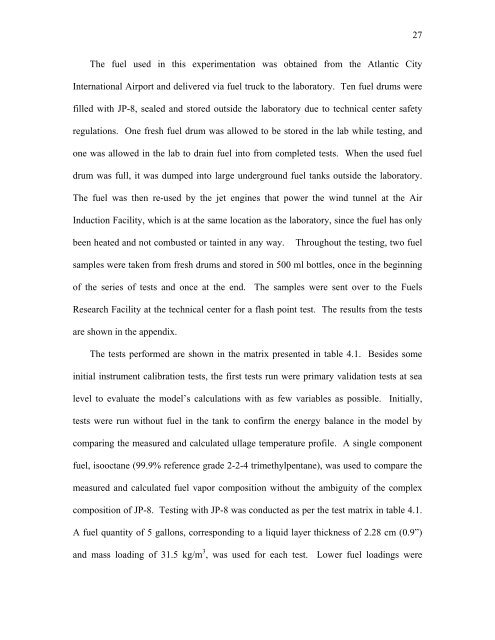Vaporization of JP-8 Jet Fuel in a Simulated Aircraft Fuel Tank ...
Vaporization of JP-8 Jet Fuel in a Simulated Aircraft Fuel Tank ...
Vaporization of JP-8 Jet Fuel in a Simulated Aircraft Fuel Tank ...
You also want an ePaper? Increase the reach of your titles
YUMPU automatically turns print PDFs into web optimized ePapers that Google loves.
The fuel used <strong>in</strong> this experimentation was obta<strong>in</strong>ed from the Atlantic City<br />
International Airport and delivered via fuel truck to the laboratory. Ten fuel drums were<br />
filled with <strong>JP</strong>-8, sealed and stored outside the laboratory due to technical center safety<br />
regulations. One fresh fuel drum was allowed to be stored <strong>in</strong> the lab while test<strong>in</strong>g, and<br />
one was allowed <strong>in</strong> the lab to dra<strong>in</strong> fuel <strong>in</strong>to from completed tests. When the used fuel<br />
drum was full, it was dumped <strong>in</strong>to large underground fuel tanks outside the laboratory.<br />
The fuel was then re-used by the jet eng<strong>in</strong>es that power the w<strong>in</strong>d tunnel at the Air<br />
Induction Facility, which is at the same location as the laboratory, s<strong>in</strong>ce the fuel has only<br />
been heated and not combusted or ta<strong>in</strong>ted <strong>in</strong> any way. Throughout the test<strong>in</strong>g, two fuel<br />
samples were taken from fresh drums and stored <strong>in</strong> 500 ml bottles, once <strong>in</strong> the beg<strong>in</strong>n<strong>in</strong>g<br />
<strong>of</strong> the series <strong>of</strong> tests and once at the end. The samples were sent over to the <strong>Fuel</strong>s<br />
Research Facility at the technical center for a flash po<strong>in</strong>t test. The results from the tests<br />
are shown <strong>in</strong> the appendix.<br />
The tests performed are shown <strong>in</strong> the matrix presented <strong>in</strong> table 4.1. Besides some<br />
<strong>in</strong>itial <strong>in</strong>strument calibration tests, the first tests run were primary validation tests at sea<br />
level to evaluate the model’s calculations with as few variables as possible. Initially,<br />
tests were run without fuel <strong>in</strong> the tank to confirm the energy balance <strong>in</strong> the model by<br />
compar<strong>in</strong>g the measured and calculated ullage temperature pr<strong>of</strong>ile. A s<strong>in</strong>gle component<br />
fuel, isooctane (99.9% reference grade 2-2-4 trimethylpentane), was used to compare the<br />
measured and calculated fuel vapor composition without the ambiguity <strong>of</strong> the complex<br />
composition <strong>of</strong> <strong>JP</strong>-8. Test<strong>in</strong>g with <strong>JP</strong>-8 was conducted as per the test matrix <strong>in</strong> table 4.1.<br />
A fuel quantity <strong>of</strong> 5 gallons, correspond<strong>in</strong>g to a liquid layer thickness <strong>of</strong> 2.28 cm (0.9”)<br />
and mass load<strong>in</strong>g <strong>of</strong> 31.5 kg/m 3 , was used for each test. Lower fuel load<strong>in</strong>gs were<br />
27
















